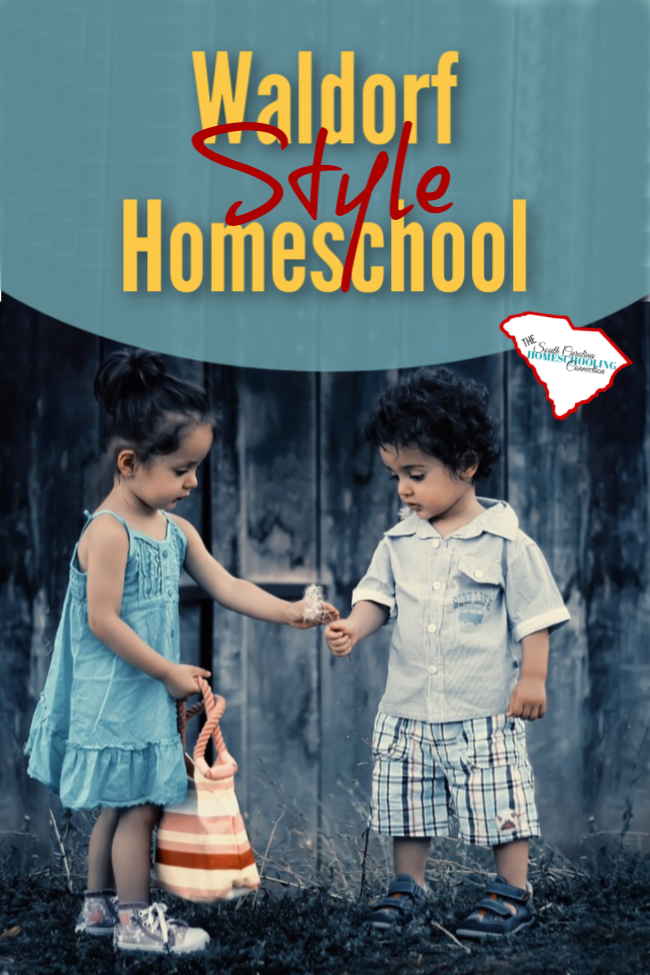In a previous post, we talked about finding your homeschool style. Let’s talk some more about Waldorf Style Homeschool–with someone who has done it. I had a chat with my friend Laura R. about how and why she implemented Waldorf in her homeschool.
Check out my guest post at Homeschool.com
–>What is Waldorf Homeschooling? <–
Waldorf Style Homeschool
The first Waldorf school opened in 1919 for children of Waldorf-Astoria Company’s employees. Since then, many independent schools, public-funded school and home schools have followed this philosophy of education. So what’s it all about? And what is it like for a homeschooler?
Waldorf education has been a beautiful marriage of our love of traditional folklore, arts and crafts as learning tools, limited technology, and delayed academics. Our family preference for simple, natural toys and open-ended play was also a great fit. I feel that the Waldorf approach has served us extremely well. I now have a twenty-year-old daughter in nursing school and a 15-year-old son still homeschooling. The lessons of the spirit learned in time spent in nature, handiwork, and creating their own lesson books continue to hold up through the teen and young adults years. ~Laura R.
Holistic Approach: Learning involves thinking, feeling and doing. “Head, heart and hands” is the foundational principle of Waldorf philosophy. Waldorf instruction is built on an interconnected balance of these components.
Laura also says that this holistic ideal is not just for the student. The teacher has their own “inner work” to do if followed correctly. This aspect is a big difference than other methods. In Waldorf education, inner work of the “teacher” is a big deal. The lessons are an outpouring of that. Although it is somewhat of a lofty goal, it’s a worthy effort.
Make your goal more about mindfulness and intention. This does not require perfection. If you strive for perfection, you set yourself up for failure. Before you create or share the lessons, you must first ponder your intentions.
“Knowledge has value only insofar as it contributes to the all-round development of the whole nature of man.” ~Rudolf Steiner
Adaptable to Worldviews: Some people think Waldorf is a religious education because Rudolf Steiner (the founder) had ties to Antroposophy. Antroposophy acknowledges a spiritual component to the world but, it is NOT a religion and doesn’t teach a certain religious view. The educational ideas came from that “world view.”
People have started blogs and written books that use Waldorf in a very Christian context or have a steeply Catholic view. It can certainly become whatever you want it to be.
“May my soul bloom in love for all existence.” ~Rudolf Steiner
Significant Elements: Waldorf, Montessori and Charlotte Mason philosophies share a few similar components: Reading to your child; Lots of storytelling and role-playing; An emphasis on nature and unstructured playtime. However, a few defining factors set Waldorf style apart from these other educational styles.
- VERY low-tech (or no tech). Instead, children have lots of wooden toys and beautiful, simple playthings
- Imagination is emphasized, so that childhood is almost “dream-like”
- Delayed academics, especially reading. No formal reading lessons till 2nd grade
- Lots of telling/re-telling stories and creating their own books.
- Handiwork for all ages. Teachers are expected to do handiwork along with the student
- Focus on seasons and holiday celebrations
Laura says that by middle school, and certainly by high school, many of these methods become even more similar with emphasis on real work: giving teens farming and outdoor tasks that include manual labor, animal care, and community involvement. Waldorf teens are heavily encouraged to participate in music, drama and art. Technology plays more a part for Waldorf teens, but still much less than traditional schools.
“The child himself is the curriculum” ~Rudolf Steiner
- Waldorf Online Library: All the available book resources on Waldorf education that are currently in print and where to purchase them. Plus, lots of articles too!
- Waldorf Answers: A straightforward presentation of the facts about Waldorf education. Lots of background information and practical advice.
- The Child is the Curriculum : A global Waldorf co-operative with support resources for homeschoolers. This is NOT an open and go curriculum provider.
- Christopherus Homeschool Resources: A Waldorf curriculum provider, plus support and encouragement resources.
- Oak Meadow: Oak Meadow is one of the few providers of secular (non-religious) homeschooling curriculum on the market. Offers curriculum for independent use and also online enrollment programs.
- Live Education! Waldorf Homeschool Curriculum and Consulting Services: Homeschooling supplies for families and institutions inspired by a Waldorf perspective. Offers individualized curriculum support.
- Waldorf Homeschool Forum: A global network of families to find inspiration and support for Waldorf education at home.
- A Local Waldorf group in SC: Conway Waldorf a group of like-minded homeschool parents who work together to build a positive experience for their children. Located in Horry county.
Read more about finding your homeschool style:
Tell Me a Story: Stories from the waldorf Early Childhood Association of North America













 Class Ranking Policies: To Rank or Not to Rank?
Class Ranking Policies: To Rank or Not to Rank? Find Your Homeschool Style
Find Your Homeschool Style Facebook Hacks for Homeschooling: Adjust Settings
Facebook Hacks for Homeschooling: Adjust Settings Normalizing Homeschooling
Normalizing Homeschooling




[…] Waldorf Style Homeschool | The South Carolina Homeschooling Connection “Let’s talk some more about Waldorf Style Homeschool–with someone who has done it. I had a chat with my friend Laura R. about how and why she implemented Waldorf in her homeschool.” […]